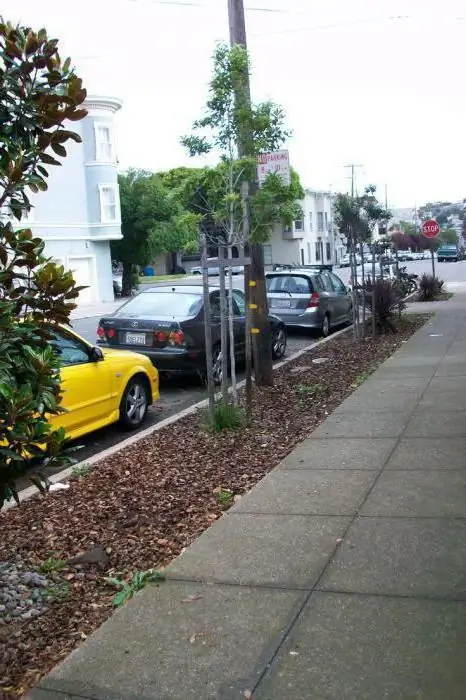Row is a term used to refer to those areas of land where the construction of road structural elements is possible. When allocating a road lane, the quality and category of the land plot are not considered. In addition to the roads themselves, facilities that provide services, as well as facilities necessary for the correct functioning of the route, can be arranged on the right of way. The right of way is the boundary of the land allocated for vehicles.

Roads and terms
Under the roadside it is customary to understand such an area that on both sides directly adjoins the place intended for the movement of vehicles. Within the boundaries of the roadside area, there is a special strict regime for the use of each square centimeter of the area. It is necessary to equip the areas in such a way that the movement by car is as safe as possible. In addition, the right of way is arranged with the expectation of the upcoming reconstruction and even major repairs. The site is created in such a way as to simplify the tasks of maintaining the track, to guarantee the longest possible safety of the road. A professional approach to allotment of land is a musttakes into account the development of the highway in the future, evaluating all possible prospects.
Roads and laws
Roadside right-of-way is not required if the road is laid in a built-up area. In all other cases, when allocating a piece of land, it is necessary to analyze the prospects for a possible increase in the flow of cars and the expansion of the route.
Current Standards:
- 75 meters for 1 and 2 categories;
- 50 meters for category 3 and 4;
- 25 meters for category 5.
When arranging, SNiP must be taken into account. Highways are places of increased danger, so reliability and quality issues come first.
Additional standards
When creating roads that would connect the capitals and administrative centers, as well as Moscow, St. Petersburg with other cities, routes that would connect common federal roads, the right-of-way must be 100 meters.
150 meters is the standard for those sections that are intended for a bypass of large settlements (those with 250,000 or more people).
The governing body of a particular entity chooses the boundaries when taking into account SNiP. Highways are the area of responsibility of the federals, municipalities, regions, and local officials. This is what the executive branch does. Roads and their boundaries are the task of local governments or those in charge of state road property.

Practical aspects
Drafting a right-of-way projectinterested party. In some cases, this is formalized as part of a state contract, if it is a road that will then be the property of the state. If it is necessary to arrange a private route, the owner takes over the tasks of the project.
It will not work to make a project “on the knee”, you will have to turn to specialists. Designers will develop a complete package of accompanying documentation, on the basis of which the authorized local authority decides on approval or sends it for revision. Only after the complete execution of the package of documents and the receipt of visas of all interested parties, it will be possible to start work. Obviously, the owner will have to pay for everything.
Who can do it?
The roadside is not a place that anyone can equip. Only true professionals are allowed to work, because it depends on how safe and reliable the track will be.
Design engineers, civil engineers with a specialization that involves the construction of roads should be involved in the work. There are no strict criteria for selecting specific workers who follow the instructions of foremen, but preference should be given to those who have already de alt with the creation of routes. The tasks are complex, require the use of special equipment, so learning from scratch is frankly not easy.

Nuances
Rows are allocated for permanent use, that is, the operation does not have a clearly defined period. And hereadditional right-of-way width, which builders receive for work, is issued only for a specified period of time - while work is underway to create the route.
The strips are being diverted in strict accordance with how the construction is progressing. Each stage has its own section. Which lanes and when are allotted is determined by the project documentation.
The choice of a land plot for the right of way is made in accordance with the land legislation in force at the moment. Also, provisions have been developed for the restoration of land, which are mandatory for accounting, since when creating a route, a strong destruction of the natural layer of soil occurs. In addition, there are other regulations, including local documentation, that are required to be taken into account for the correct allocation and creation of right-of-ways of the highway.
Rows in tables

The tables presented to your attention show how large the width of the stripes should be.

The category of roads and how many lanes there will be are key factors in determining a specific amount. In addition, lateral reserves and excavations, slopes, if any, are laid down by the design documentation.

Summing up
Creating a highway is not an easy task that requires an exceptionally responsible approach. When building a new route, a prerequisite is the correct creation of the project, taking into account not onlythe demands of the present, but also the prospects for the coming decades.

Correct reasoning when demanding land from the state ensures that the builders will have at their disposal the required number of meters along the road under construction. This will help to safely position the vehicles used in the work and ensure the quality of the road itself. The right-of-way created by this will be the key to the safety of motorists on the highway in the future.
When creating a right of way, it must be taken into account that this territory is actively used to equip service points. For them, in turn, it is necessary to make the infrastructure. Taking into account the future development of the territories, already in the road design it is possible to guarantee that the lanes will be sufficient in size, reliable and fully satisfying the requirements not only at the time of construction, but also in the future.






